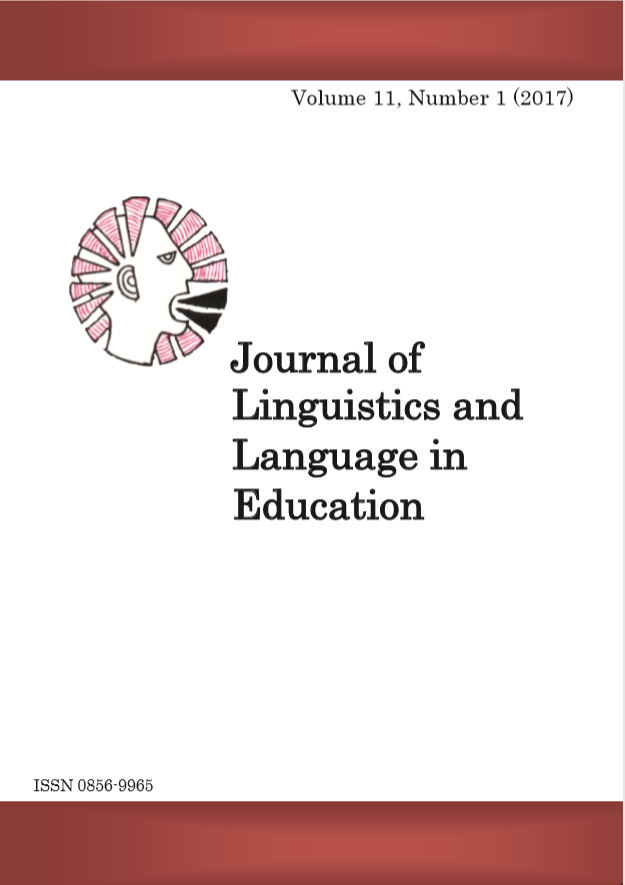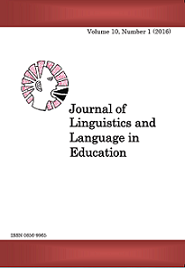Efficacy of Communication Skills Teaching Methods and Learning Strategies: Enhancing Tertiary Students ' Communicative Competence in Tanzania
Abstract
This study evaluates the efficacy of the methods and strategies used in
Communication Skills (CS) course teaching and learning in Tanzania.
Specifically, it identifies the methods and strategies used, and examines
the appropriateness of the same in upgrading students ' CS. The study
involved 596 respondents, and data were collected through
questionnaires, interviews, and group discussions. It is indicated that
instructors use varied methods, but questions and answers, web
browsing, and library research are perceived the most appropriate.
Besides, students also use multiple strategies but group discussions, web
browsing, and listening to English conversations are considered the most
appropriate. Therefore, instructors are urged to spend some time during
students ' entry to university to study the incoming students, particularly
on how they learn/ behave during the learning process, to accommodate
the students ' learning differences, difficulties, and preferences when
selecting teaching methods. Also, establishing a strict filtering
mechanism as an option to improve students ' CS, proposed by
Rugemalira (2017), is a good proposal. However, currently, it can result
in filtering all applicants because many have low language proficiency.
Instead, what we need to do meanwhile, is stressing on formalising the
use of modern mobile technologies in the teaching since have been
revealed to be appropriate.
References
Al-Mahrooqi, R. & Denman, J. (2016). Omani Graduates ' English-
Language Communication Skills in the Workforce:
Employees ' Perspectives. International Journal of Applied
Linguistics & English Literature , 5(4):172-182.
Ayeni, A.J. (2011). Teachers ' Professional Development and Quality
Assurance in Nigerian Secondary Schools. World Journal of
Education, 1(2):143-149.
Eke, H. N., Omekwu, C. O. & Odoh, J. N. (2014). The Use of Social
Networking Sites among the Undergraduate Students of
University of Nigeria, Nsukka. Library Philosophy and
Practice (e-journal). 1195. Retrieved on September 11, 2020
from http://digitalcommons.unl.edu/libphilprac/1195
Benbow, J., Mizrachi, A., Oliver D & Said-Moshiro, L. (2007). Large
Class Sizes in the Developing World: What do we Know and
What can we do? USAID.
| Efficacy of Communication Skills Teaching Methods and Learning Strategies
Blatchford, P., Bassett, P. & Brown, P. (2005). Teachers ' and Pupils '
Behaviour in Large and Small Classes: A Systematic
Observation Study of Pupils Aged 10/11 Years. Journal of
Educational Psychology , 97(3): 454-467.
Byrd, P. & Reid, J. (1998). Grammar in the Composition Classroom:
Essays on Teaching ESL for College-bound Students.
Portsmouth, NH: Heinle & Heinle.
Canale, M., & Swain, M. (1980). Theoretical Bases of Communicative
Approaches to Second Language Teaching and Testing.
Applied Linguistics , 1: 1-47.
Faraday, S., Overton, C. & Cooper, S. (2011). Effective Teaching and
Learning in Vocational Education: London, UK.
Fattah, F. S. (2015). The Effectiveness of Using WhatsApp
Messenger as One of Mobile Learning Techniques to Develop
Students' Writing Skills. Journal of Education and Practice ,
(32): 115-127
Ferreira, M. J., Moreira, F. Pereira, C. S. & Durão, N. (2015). The
Role of Mobile Technologies in the Teaching/Learning
Process Improvement in Portugal , Proceedings of ICERI
Conference 16th-18th November 2015, Seville, Spain.
Giles, J., Ryan, D. J., Belliveau, G., De Fritas, E. & Casey, R. (2006).
Teaching Style and Learning in a Quantitative Classroom.
Active Learning in Higher Education, 7(3): 213-225.
Gill, K.A & Kusum, D. (2017). Teaching Approaches, Methods and
Strategy. Scholarly Research Journal for Interdisciplinary
Studies, 4(36): 6692-6697.
Hyland, K. (1997). "Is EAP Necessary?" A Survey of Hong Kong
Undergraduates. Asian Journal of English Language
Teaching, 7(2): 77-99.
Ishengoma, R.F & Mtaho, B.A. (2014). Online Social Network as a
Tool for Facilitating e-Learning inTanzania. International
Journal of Open I nformation Technologies , 2(10): 29-35.
Jordan, R. (1997). English for Academic Purposes: A Guide and
Resource Book for Teachers. Cambridge: Cambridge
University Press.
Kitti, M. R. (2014). Effect of Teaching Methods on Students '
Performance in Tanzanian Education Institutions: A Case of
Public Secondary Schools in Nyamagana District €“ Mwanza.
Master of HRM of the Open University of Tanzania.
Komba, S. C. (2008). The Impact of Communication Skills Course on
Students ' Development of Communicative Abilities.
Unpublished MA Education, Dissertation. University of Dar
es Salaam, Tanzania.
Journal of Linguistics and Language in Education Volume 14, Number 2 (2020) |59
Lahiry, S., Choudhury, S., Chatterjee, S. & Hazra, A. (2019). Impact
of Social Media on Academic Performance and Interpersonal
Relation: A Cross-sectional Study among Students at a
Tertiary Medical Center in East India. Journal of Education
and Health Promotion, 8: 73.
Macaro, E. (2001). Strategies in Foreign and Second Language
Classrooms. London: Continuum.
Maharsi, I. (2006). The Academic Writing Experience of
Undergraduate Industrial Technology Students in Indonesia.
Global Perspectives, Local Initiatives , 145-158.
Mohamed, H. I. (2006). Academic Writing as Social Practice: A
Critical Discourse Analysis of Student Writing in Higher
Education in Tanzania. Unpublished Doctoral Thesis,
University of the Western Cape, Cape Town.
Mbowe, D. C. (1994). Factors Influencing Lack of Interest in the
English Communication Skills Course among Students in
Tanzanian Technical Training Institutions. Unpublished MA
Education Thesis. University of Dar es Salaam, Tanzania.
Mcha, Y. Y. & Rea, P. (1985). The Impact of Communication Skills in
English Courses with Special Reference to Students in the
Faculty of Arts and Social Sciences. Papers in Education and
Development , 10: 61-64.
Mwalimu, F. M. (1998). Students ' Attitudes and Motivation as
Factors Influencing the Learning of the Communication
Skills Courses in Tertiary Institutions in Tanzania.
Unpublished MA Thesis. University of Dar es Salaam,
Tanzania.
Msuya, E. A. (2011). Communication Skills Course Relevance and
Effectiveness at the University of Dar es Salaam. PhD
Thesis, University of Dar es Salaam.
Noviyenty, L. (2018). Strategies in Learning and Techniques in
Teaching English Speaking. Academic Journal of English
Language and Education, 2(1): 35-48.
Nkatha, M. D. Kimwele, M. & Okeyo, G. (2015). The Use of Social
Networking Sites for Learning in Institutions of Higher
Learning. International Journal of Scientific and Technology
Research, 4(12): 51-56.
Odubiyi, A. O. (1988). Perceptions of Iowa Vocational Agricultural
Teachers Regarding Teaching Methods Used in Agricultural
Education. Unpublished Master's Thesis, Iowa State
University, Ames, l A.
| Efficacy of Communication Skills Teaching Methods and Learning Strategies
O ' Malley, J. M. & Chamot, A. U. (1990). Learning Strategies in
Second Language Acquisition. Cambridge: Cambridge
University Press.
Oluwalanu, S. B., Omowale, A. & Kayode, O. J. (2014). Adapting
Social Media for Formal Learning in Nigeria: Challenges and
Prospects. Arabian Journal of Business and Management
Review, 3(9): 22-30.
Oxford, R. L. (1990). Language Learning Strategies: What Every
Teacher should Know. Boston: Heinle and Heinle.
Palos, R. & Petrovici, M. C. (2014). Perceived Importance of
Communication Skills and their Predictive Value for
Academic Performance. Revista de Cercetare si Interventie
Sociala, 46: 85-98.
Peacock, M. (2001). Match or Mismatch? Learning Styles and
Teaching Styles in EFL. International Journal of Applied
Linguistics, 11(1): 1-20.
Pratiwi, D. M. (2015). Classroom Techniques to Develop Students '
English Writing Skill: An Article Submitted as a Partial
Fulfillment of the Requirements for Getting a Bachelor
Degree of Education in English Department,
Muhammadiyah University of Surakarta.
Rivers, W. M. (1981). Teaching Foreign-language
Skills (2nd Education). Chicago: University of Chicago Press.
Richards, J. C. & Rodgers, T. S. (2001). Approaches and Methods in
Language Teaching (2nd Education). Cambridge: Cambridge
University Press.
Rugemalira, J. (2017). Language Skills for Higher Education in
Tanzania. Journal of Linguistics and Language in Education,
(2):1-21.
Sajjad, S. (2011). Effective Teaching Methods at Higher Education
Level. Unpublished Research, Submitted to the University of
Karach Pakstan.
Soliven, S. R. (2003). Teaching Styles of High School Physics
Teachers. Retrieved from
http://www.hiceducation.org/EduProceedings on December
, 2018.
Shinn, Y. H. (1997). Teaching Strategies, their Use and Effectiveness
as Perceived by Teachers of Agriculture: A National Study,
Unpublished PhD Thesis, Iowa State University, USA.
Shrum, J. L. & Glisan, E. W. (2009). Teacher ' s Handbook:
Contextualized Language Instruction (4th Education).
Boston: Heinle.
Journal of Linguistics and Language in Education Volume 14, Number 2 (2020) |61
Talley, L. A. (2017). Best Teaching Strategies to Help Struggling
Readers. Unpublished Doctoral Dissertation, Carson-
Newman University, USA.
Tanzania Commission of Universities (TCU) (2018). List of
Undergraduate Degree Programmes Approved to Admit
Students in 2018/2019 Academic Year (For Holders of Form
Six Qualifications ), Dar es Salaam: Government printer.
Tosun, N. (2014). A Study on Reading Printed Books or E-Books:
Reasons for Student-Teachers Preferences. The Turkish
Online Journal of Educational Technology , 13(1): 21-28.
Thomson, M. (2020, June 23). Regional Briefs: Covid-19 e-learning
Guidelines.The Citizen: 10.
University of Dar es Salaam (UDSM). (1983). Intensive Grammar
Programme: A Workbook in Basic Grammar for Academic
Purposes, Communication Skills Unit, UDSM.
Wong, W. L. H. (2015). A Study of Language Learning Style and
Style Preferences of Hong Kong Community College
Students and Teachers in English for Academic Purposes
Context. PhD Thesis, University of Canterbury, New
Zealand.
Woody, W. D., Danie, D. B. & ve Baker, C. A. (2010). E-books or
Textbooks: Students Prefer Textbooks. Computers &
Education, 55: 945-948.
Downloads
Published
Issue
Section
License
Copyright © by Department of Foreign Languages and Linguistics, University of Dar es Salaam
All rights reserved. No part of this publication may be reproduced or transmitted in any form or by any means, electronic or mechanical, including photocopying, recording, or any information storage or retrieval system, without permission in writing from the publisher, except for short extracts in fair dealing, for research or private study, critical scholarly review or discourse with an acknowledgement.



